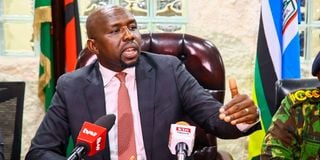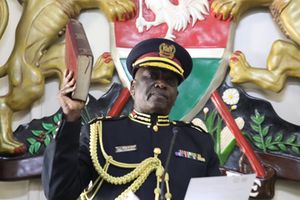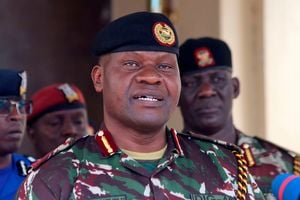Relief for motorists as Murkomen backtracks on plans to increase road levy

Cabinet Secretary for Roads and Public Works, Kipchumba Murkomen.
What you need to know:
- The Kenya Roads Board had proposed the increase of the charges from the current Sh18 to Sh25.
- KRB said the collection has stagnated at Sh80bn a year against an annual maintenance of Sh157bn.
Motorists have got a reprieve from the planned increase of Sh7 in the prices of petroleum products at the pump under the Fuel Levy Fund.
It follows rejection of the plans by motorists and the business community, forcing the government to look for alternative means to raise a shortfall of Sh78 billion in the current financial year.
The Kenya Roads Board (KRB), which collects the levy, had proposed the increase of the charges from the current Sh18 to Sh25 for both petrol and diesel effective from July 1, 2024 to raise the funds meant for Roads Maintenance Levy (RML).
According to KRB, an increase in the levy would have enabled the government to raise the collection to Sh115 billion annually.
KRB has stated that the collection currently has stagnated at Sh80 billion a year against an annual maintenance of Sh157 billion.
Cabinet Secretary for Roads and Public Works, Kipchumba Murkomen, announced on Monday that the government will look for alternative means of raising the money to maintain roads most of which are dilapidated.
The 4,400 Low Volume Seal Roads (LVSR) in the 290 constituencies, which were rolled out in 2014 by the Kenya Rural Roads Authority (Kerra) are the most affected for they do not have maintenance vote head.
“Kenyans have told us that, yes, you need money but make sure you do not raise fuel at the pump. We shall think how to do this because we are paid to think,” Mr Murkomen said yesterday during a public participation meeting at the ministry headquarters," Mr Murkomen said.
“We will analyze received on email and social media platforms as well as submissions made today, and come up with a decision that corresponds with the recommendations from the public.
“We will explore ways of getting the resources needed to maintain roads, as expressed by Kenyans in their numbers without raising the cost of living through an increase in petroleum prices,” the CS added.
President William Ruto’s administration was banking on the ongoing Roads Maintenance Levy Review, which was last done in 2016, to raise funds to plug the deficit in the budgetary allocation.
“As a country, we are grappling with a maintenance deficit of Sh78 billion in the current financial year. With the current trend, it is projected that by Financial Year 2028/2029 the gap will rise to Sh315 billion,” Mr Murkomen said.
Under the 2023-2027 Work Plan, KRB proposes that Sh3 will go to Roads Annuity Fund while Sh20 would go to roads construction, rehabilitation and development.
The KRB spent Sh309 billion on road maintenance, rehabilitation and development programmes according to available records.
The money is distributed through Kenya National Highways Authority (Kenha), Kenya Rural Roads Authority (Kerra), Kenya Urban Roads Authority (Kura), Kenya Wildlife Services and the county governments
The roads maintenance backlog has grown from Sh445 billion to Sh727 billion according to Kenya Roads Board.
The value of roads established under the Road Sector Investment Programme (2023-2027) is Sh4 trillion with a financing gap of Sh315 billion.
The Roads network has in the last eight years grown from 161,451 kilometres to 249, 122 kilometres reflecting an increase of 77,671 kilometres according to Mr Murkomen.
Mr Murkomen has described the Low Volume Seal Roads (LVSR) as “orphaned roads” owing to the lack of funds for maintenance of the strategic infrastructural development which was rolled out in 2014.
President William Ruto’s Kenya Kwanza administration inherited them from former President Uhuru Kenyatta’s Jubilee government following the hand-over of power on September 13, 2022.
The Economic Survey 2021 that the roads network which were to be expanded from 4,400 to 7,000 kilometres in 2022, had cost the taxpayers Sh316 billion at the time, but the latest records shows the cost had shot up to Sh376 billion.
It appears that when the decision was made to construct 10,000 kilometres of roads in all the constituencies in the country, a vote for their maintenance was not factored into the subsequent annual budgets by the national government.
“The LVSR have been rendered as orphaned roads for lack of allocation for their maintenance in the budget allocated to the Kenya Rural Roads Authority (Kerra) annually,” Mr Murkomen said in Kapkatet, Kericho county on Saturday.
The LVSRs were initially designed for motor vehicles with low tonnage, but a spot check shows that they are used by heavy trucks leading to damages due to lack of enforcement of traffic rules on tonnage.
The technology (LVSR) was adopted by the government to open up rural roads in the country under an annuity programe rolled out by Kerra.
It was adopted due to the fact that it was 60 per cent lower than the conventional high volume seal roads which are equally more durable.
Two key roads – Silibwet-Kiptagich-Olenguruene, Chebole-Siongiroi-Chebunyo roads linking Bomet, Nakuru and Narok counties are examples of LVS roads which are worn out and urgently require funds for repairs.
The government is also faced with a Sh41 billion bill in the bid to rehabilitate roads and bridges that were destroyed during the recent floods across the country.
According to the Kenya Urban Roads Authority (Kura) bridges destroyed were valued at Sh15 billion while roads under the Kenya National Highways Authority (Kenha) runs to Sh17 billion and Kenya Rural Roads Authority (Kerra) cost taxpayers’ Sh9 billion.
Mr Murkomen said it was important for Kenyans to understand that the infrastructural development challenges being experienced in the country could be traced to Mr Kenyatta’s administration.
“When President William Ruto took over power there was a Sh165 billion debt for road contractors that had not been paid for two years in what led to the stalling of most of the projects which we have since kick-started,” Mr Murkomen said.
President Ruto’s administration inherited a Sh900 billion portfolio for ongoing infrastructure projects from the former Jubilee government, which was later frozen at Sh700 billion after an audit.
The ministry of roads had a Sh 50 billion development vote in the last financial year with a pending bill of Sh165 billion.
The CS said it was unfortunate that as a result of the spiraling debts, many contractors have become bankrupt adding that the debts were still outstanding.
“The government has been grappling with the debt inherited from the Jubilee regime and we have had to literally sit down with contractors to discuss how to deal with the outstanding debts and impress upon them to return to site and embark on the projects they were undertaking,” Mr Murkomen said.
Appearing to take the cue from President Ruto who engaged Kenyans on X platform last Friday, Mr Murkomen said to demonstrate the performance of his ministry, he was ready to engage Kenyans on a public platform on the roll out of Kenya Kwanza development agenda.
“I am ready to engage with Kenyans on X and whatever space available on the issues affecting my ministry and the strides we have made. I am ready even tomorrow to engage so that we stop the misinformation being bandied around by our critics,” Mr Murkomen said.
It remains to be seen how the government, with the austerity measures put in place, will handle the infrastructural facilities that are dilapidated and those whose construction is ongoing.





